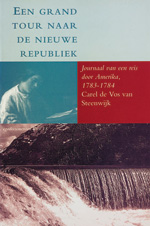Travel journals up to 1814 - Introduction
Dutch travel journals from the sixteenth to the early nineteenth centuries.
The Dutch have a reputation as travellers. From early times they have been a nation of merchants who journeyed across the continent by boat and coach and sallied forth in all directions on ships from the many ports on the North Sea. Besides the merchants, Dutch diplomats, scholars, soldiers, sailors and artists explored the entire world. Many of them entrusted their travel experiences to paper. The travel journal is a genre that has flowered in the Netherlands since the late Middle Ages. Such documents form an important source both for Dutch history and that of the many countries visited.
Until recently no overview existed of surviving travel journals. For that reason a project was set up in the mid 1980s to inventory such texts in Dutch archives and libraries, as part of a larger project to track down all types of ego documents from the period c. 1500-1814.
In addition to travel journals, autobiographies, memoirs and diaries were recorded. The search was conducted in public archives and libraries, but not in private collections. As far as the travel journals were concerned we restricted ourselves to texts in manuscript. This quest through Dutch archives and libraries turned up 490 manuscript travel journals, now recorded chronologically in a published list with a short description of the author, the manuscript, the destinations and the motives for writing about the voyage.
In terms of criteria of selection we limited ourselves to those travel journals that could be defined as ego documents, that is to say that the author had to write about his own experiences or provide personal commentary. Impersonal accounts that were really more like travel guidebooks were not included. Furthermore, we only selected texts that were written on personal initiative and not in an official capacity. Thus the many diplomatic reports and ship's logs found in government archives were left out of consideration, even though they sometimes contain personal passages. Whenever a diplomat or a ship's captain kept a personal diary in addition to his official record it has been included. It was not always easy to draw the line, which will come as no surprise for a time when the personal and the public spheres were still strongly intertwined.
Also excluded from our list of travel journals are the manuscripts of authors who kept a diary and went on an occasional trip. Such texts have been included among the other sorts of ego documents. The same holds true for authors who described their travels in their autobiographies. Individual letters written while travelling have not been included; the journal consistently had to concern the whole trip, or in any case, a great part of it. On the other hand we did include a few series of travel letters since they may at times have the character of a journal, especially drafts that were not sent. As a rule, most of the accounts of people who travelled professionally, in particular soldiers on campaign abroad, have been placed with the other ego documents. The same is true for the Patriot and Orangist exiles who left the country for several years in the last decades of the eighteenth century. The various categories under which we classified the travel accounts included will be elaborated in the rest of this article. As a final criterion for inclusion we retained a minimum length of ten pages.
It should be said that the project has not ended with the appearance of the published guide. In the first place a number of travel accounts will appear in the series of ego documents being published in the Netherlands by Uitgeverij Verloren with the support of the Prins Bernhard Fonds. In the second place, the manuscript material will be made available on microfiche by MMF Publications. To begin with all the manuscripts in languages other than Dutch have been filmed, thus opening up an important body of sources for further research.
For more information, see Rudolf Dekker, 'Dutch Travel Journals' (pdf)

